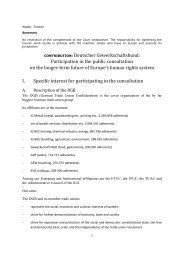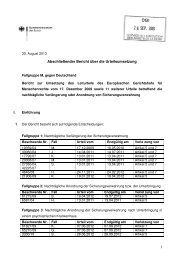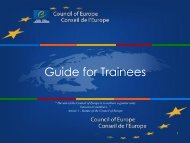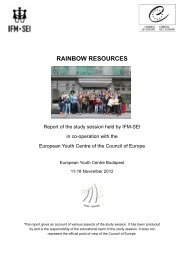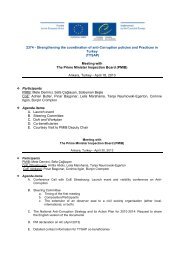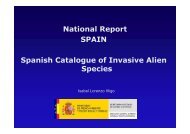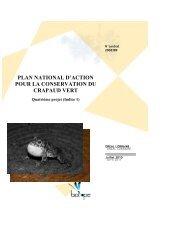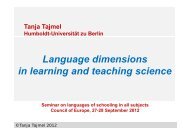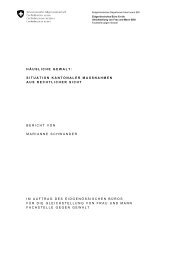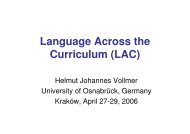SENJE COAL MINE Senjski Rudnik SERBIA - 404 Page not found
SENJE COAL MINE Senjski Rudnik SERBIA - 404 Page not found
SENJE COAL MINE Senjski Rudnik SERBIA - 404 Page not found
Create successful ePaper yourself
Turn your PDF publications into a flip-book with our unique Google optimized e-Paper software.
<strong>SENJE</strong> <strong>COAL</strong> <strong>MINE</strong><br />
<strong>Senjski</strong> <strong>Rudnik</strong><br />
<strong>SERBIA</strong>
<strong>SENJE</strong> <strong>COAL</strong> <strong>MINE</strong><br />
<strong>Senjski</strong> <strong>Rudnik</strong><br />
<strong>SERBIA</strong>
FOREWORD<br />
In the framework of the European Commission/Council of<br />
Europe Joint Programme on the Integrated Rehabilitation<br />
Project Plan/Survey on the Architectural and Archaeological<br />
Heritage (IRPP/SAAH), the present Preliminary Technical<br />
Assessment (PTA) of the « Consolidated Project » for the<br />
“Ljubljana Process – Funding Heritage Rehabilitation in South-<br />
East Europe”, was prepared by local experts: Mr. Miroslav<br />
Nikolic, Mr. Zoran Jaglic, Mr. Rifat Kulenovic, Ms.Mirjana Andric<br />
and Mr. Marko Omcikus, headed by Ms Tatjana Sarcevic,<br />
IRPP/SAAH Project Co-ordinator.<br />
This assessment was finalised with the assistance of the PTA<br />
expert group: Leader Dr. John Bold (United Kingdom); Experts:<br />
Mr. Martin Cherry (United Kingdom), Mr.David Johnson (United<br />
Kingdom), Mr. Friedrich Lüth (Germany), Mr. Alkis Prepis<br />
(Greece).<br />
The Preliminary Technical Assessment (PTA) was adopted in<br />
2005 and was revised by the Ministry of Culture of the Republic<br />
of Serbia in July 2008 in order to reflect the “Ljubljana Criteria”.
Preliminary Technical Assessment of the Architectural and Archaeological Heritage in South East Europe<br />
1<br />
___________________________________________________________________________________________________________<br />
1. INTRODUCTORY PAGE<br />
Site map<br />
<strong>Senjski</strong> rudnik<br />
Country or Territory<br />
Name of organisation<br />
compiling the information<br />
Contact name<br />
Email address<br />
Name and address of building or site<br />
Inventory reference<br />
Monument/Site type<br />
Main dates<br />
Current use(s)<br />
Republic of Serbia<br />
Ministry of Culture of the Republic of Serbia,<br />
Belgrade, Regional Institute for the Protection of<br />
Monuments,Kragujevac and Senje Coal Mining<br />
Museum, <strong>Senjski</strong> <strong>Rudnik</strong><br />
Borislav Šurdić , Ministry of Culture of the Republic<br />
of Serbia.<br />
borislav@min-cul.sr.gov.yu<br />
<strong>Senjski</strong> rudnik, (Senje coal mine and urban area)<br />
Registry number IPM Kragujevac 23, number(s):<br />
Registry number RIPM of Serbia, SK 606<br />
R 66/1, 24.02.1975 IPM Kragujevac<br />
Industrial Heritage Area<br />
1853: opening date of the mine, 1892: opening of the<br />
rail road, opening of the railroad connection with<br />
Resavica.<br />
Coal mine, still in service, along with the town<br />
community that has grown up around the mine.<br />
2. EXECUTIVE SUMMARY<br />
<strong>Senjski</strong> <strong>Rudnik</strong>, is the birthplace of the industrialisation of Serbia. Established in 1853, it is Serbia’s oldest<br />
coal mine, complete with shafts, workshops and administrative buildings. The mine is part of an urban<br />
ensemble which also includes houses, a school, a cultural activities centre, a railway station, a church,<br />
museum and a hospital, many of which are still in use. This is a typical industrial community of the 19th-20th<br />
centuries, now in economic and physical decline, in need of new sources of income and employment. The<br />
____________________________________________________________________________________________________________<br />
Senje Coal Mine – <strong>Senjski</strong> <strong>Rudnik</strong> – Serbia 13 November 2008
Preliminary Technical Assessment of the Architectural and Archaeological Heritage in South East Europe<br />
2<br />
___________________________________________________________________________________________________________<br />
mine is still in operation but it is estimated that the coal reserves will run out in seven to ten years with a<br />
consequent risk of depopulation.<br />
The village is sited on the River Ravanica, in a hilly and surprisingly unspoilt landscape in central Serbia,<br />
south of Belgrade, in the vicinity of two famous mediaeval monasteries: Ravanica and Manasija, as well as<br />
many other attractions such as caves, waterfalls, a ski-centre and mountain biking facilities. This is a place<br />
of considerable potential for tourism which could be encouraged as part of the regional development<br />
programme, through for example the establishment of an eco-museum and a national industrial heritage<br />
centre, <strong>not</strong> only for the benefit of tourists, but also as an affirmation of the fundamental importance of this site<br />
for the local community. The restoration of the industrial buildings (particularly the shafts and the narrowgauge<br />
railroad) should transform this dying settlement into a cohesive tourist centre.<br />
The historical significance of the mine is considerable since it is the oldest preserved industrial area in Serbia<br />
and, in the period from the building of the railway in 1892 until 1941, it was one of the most prosperous<br />
industrial regions in the country. The mine shafts themselves - Alexander’s Shaft of 1853, the first in Serbia,<br />
and the Main Shaft, still in use and retaining 19th century steam machinery and headgear - are of<br />
outstanding national importance. Although the condition of many of the buildings at the mine and in the town<br />
is bad, and will continue to deteriorate, the majority at least survive. This survival, together with the wellpreserved<br />
urban structure, the splendid cultural landscape and the solid documentation held in the local<br />
museum, joined with the industrial tradition of the population, offers an excellent basis for authentic<br />
restoration and the comprehensive rehabilitation of the whole ensemble, from the industrial buildings to the<br />
social and commercial. The necessary addition of new buildings for the accommodation of tourists must be<br />
done in a manner which respects the existing building pattern and character of the village. Such a project<br />
requires <strong>not</strong> only the full support of the national institutes and professional bodies but for long term<br />
sustainability, the rehabilitation must be supported by the local population for whom there must be a great<br />
deal of self-help and self-governance.<br />
<strong>Senjski</strong> <strong>Rudnik</strong> offers an excellent opportunity to achieve a sustainable development which respects the<br />
historic fabric of the mine and the village, and encourages new uses which enable the continuation in situ of<br />
the long-established community.<br />
It is the reason why the rehabilitation of <strong>Senjski</strong> <strong>Rudnik</strong> has been chosen as a flagship project in the<br />
IRPP/SAAH funding phase.<br />
3. ADMINISTRATIVE INFORMATION<br />
3.1 Responsible Authorities<br />
Ministry of Culture of the Republic of Serbia<br />
Public Company for the Coal Exploitation “Resavica”<br />
Direction of Coal mine REMBAS, Resavica,<br />
Municipality of Despotovac,<br />
RIPM of Serbia-Belgrade,<br />
IPM Kragujevac<br />
3.2 Building/Site, Name and Address<br />
Mesna zajednica<br />
<strong>Senjski</strong> <strong>Rudnik</strong>,<br />
ZIP Code 23437.<br />
3.3 Map Reference<br />
Latitude: 44° 00´N<br />
Longitude: 21° 38´E<br />
Altitude: 500 – 600 metres above sea level<br />
____________________________________________________________________________________________________________<br />
Senje Coal Mine – <strong>Senjski</strong> <strong>Rudnik</strong> – Serbia 13 November 2008
Preliminary Technical Assessment of the Architectural and Archaeological Heritage in South East Europe<br />
3<br />
___________________________________________________________________________________________________________<br />
3.4 Type of Monument<br />
Industrial Heritage Area, landscape of industrial heritage (mining shafts, auxiliary buildings:<br />
workshops, stores, warehouses, residential buildings, school and surrounding landscape).<br />
3.5 Ownership<br />
State property, (some individual buildings though, are privately owned)<br />
3.6 Statutory Protection/Constraints<br />
Today the legal protection is limited only to the oldest shaft, Alexander’s Shaft, and the nearby<br />
Workshop and Museum, and dates from 1975. Protected as individual monuments.<br />
Under the Protection of the Republic of Serbia as a “property of great importance”, since 1979.<br />
(monitoring of the RIPM of Serbia).<br />
4. SUMMARY OF CONDITION<br />
4.1 Summary of Physical Condition – Very Bad to Good<br />
Considered as an area, it is in a bad state. Most of the buildings are in a condition from very bad to<br />
bad. The surrounding landscape is in a rather good condition.<br />
4.2 Condition Risk Assessment - Graded A-H<br />
Overall risk is high: C, the risk for individual objects within the area varies from B to G.<br />
A more detailed risk assessment will be <strong>found</strong> in paragraph 7.3 below.<br />
4.3 Priority for Intervention - High/Medium/Low<br />
Medium to high.<br />
5. EXISTING INFORMATION<br />
5.1 Documentary Sources<br />
Large documentation and sources are available in the Museum, and in the Archives of Serbia.<br />
5.2 Bibliography<br />
1. “Sto godina Senjskog rudnika”, <strong>Senjski</strong>-resavski rudnici mrkog uglja, 1953 (a book celebrating the<br />
one hundredth anniversary of Senje Coal Mine)<br />
2. “Od nezdravog kamena do crnog zlata”, 150 godina Senjskog rudnika (1853 – 2003), Resavica<br />
2004, (a book celebrating the one hundred and fiftieth anniversary of the Senje Coal Mine).<br />
3. Tomic, Stojadin, <strong>Senjski</strong> <strong>Rudnik</strong>,/a Social history of the place/, Despotovac, 2008.<br />
5.3 Fieldwork Already Conducted<br />
A conceptual project of the Rehabilitation of the urban area and restoration of buildings of historical<br />
importance, 1973. Documentation in IPM Kragujevac.<br />
Partly realized.<br />
The main (executive) Project of the Museum, workshop, and Alexander’s Shaft.<br />
____________________________________________________________________________________________________________<br />
Senje Coal Mine – <strong>Senjski</strong> <strong>Rudnik</strong> – Serbia 13 November 2008
Preliminary Technical Assessment of the Architectural and Archaeological Heritage in South East Europe<br />
4<br />
___________________________________________________________________________________________________________<br />
There are existing projects for i.e. the restoration of the Workshop (object no 2 in Appendix 1), near<br />
the Alexander’s Shaft dating from the 1970s and the 1980s, which, due to political unrest and<br />
shortage of funds, have never been realised.<br />
5.4 Projects in Progress<br />
1. Project for transformation of the coal mining museum to the local heritage. centre and ecomuseum.<br />
2. Cleaning Aleksandar’s Shaft.<br />
5.5 Projects Already Planned<br />
A conceptual project of the Rehabilitation of the urban area and restoration of buildings of historical<br />
importance, 1973. Documentation in IPM Kragujevac.<br />
Partly realized.<br />
The main (executive) Project of the Museum, workshop, and Alexander’s Shaft.<br />
There are existing projects for i.e. the restoration of the Workshop (object no 2 in Appendix 1), near<br />
the Alexander’s Shaft dating from the 1970s and 1980s, which, due to political unrest and shortage<br />
of funds, have never been executed.<br />
5.6 Financial Estimates Already Made<br />
Due to the numerous denominations, complete transformations of economic systems, financial<br />
estimates from the 1970s and 1980s are nearly totally irrelevant.<br />
6. SCOPE OF THE PTA<br />
6.1 Extent/Nature of the Assessment:<br />
Individuals involved in the PTA work:<br />
This is a revised version of the PTA compiled in October 2004.<br />
In May 2008, after the adoption of the Feasibility study for the rehabilitation of Aleksandar’s Shaft,<br />
historically the most important part of the site and the announcement of this project as a flagship<br />
project of the Republic of Serbia in the funding phase of the IRRPPP/SAAH, a short field trip was<br />
organised, together with the special team of mining engineers. This team investigated the condition<br />
of the Shaft, checking the possibilities for the use of a Shaft as an exhibition room.<br />
(The scope of the PTA 2004)<br />
Marco Omcikus, Documentalist, Republican IPM, Belgrade<br />
Rifat Kulenovic, Industrial Archaeologist, Republican IPM, Belgrade<br />
Borislav Šurdić, IRPP/SAAH project co-ordinator, Ministry of Culture, Serbia<br />
Andreas Heymowski, Conservation Architect, Stockholm, Sweden<br />
Miroslav Nikolić, Curator, Senje Mining Museum,<br />
Mirjana Andric, Conservator, IPM Kragujevac, Director<br />
Zoran Jaglić architect, Conservator, IPM Kragujevac.<br />
The field work was prepared by Miroslav Nikolić, from the Mining Museum in Senski <strong>Rudnik</strong>, by<br />
Mirjana Andrić from the Regional IPM in Kragujevac, and by Borislav Šurdić from the Ministry of<br />
Culture, Belgrade. The field work was conducted 17 – 20 October 2004, with a preparatory meeting<br />
in Belgrade on 17 October, a field visit to <strong>Senjski</strong> <strong>Rudnik</strong> on 18 – 19 October, and a summarising<br />
meeting at Mr. Surdic´s office in Belgrade on 20 October.<br />
____________________________________________________________________________________________________________<br />
Senje Coal Mine – <strong>Senjski</strong> <strong>Rudnik</strong> – Serbia 13 November 2008
Preliminary Technical Assessment of the Architectural and Archaeological Heritage in South East Europe<br />
5<br />
___________________________________________________________________________________________________________<br />
7. THE PTA<br />
7.1 Background: Form, Function and Evolution<br />
7.1.1 Summary Description of the Site<br />
Serbia’s oldest coal mine and colliery, complete with shafts, administration buildings,<br />
storage and workshops. Situated in a hilly, rural landscape in central Serbia, 150 km south<br />
of Belgrade. The mine is surrounded by an old, well-preserved village community, typical of the<br />
19th – 20th century industrial communities. Some typical stages of urban development and<br />
technological changes are clearly evident.<br />
7.1.2 Summary Historic Development and Evolution of the Site<br />
The mine was opened in 1853, after Serbia had gained its independence, and with the aid of<br />
German engineers. Interpreting local architectural heritage, urban shape and testimonies of<br />
industrial culture, one can discover five distinctive stages:<br />
- Establishing a mine and settlement (1853-1892).<br />
- Building of a railway connecting the coal mine with central Serbia (1892)<br />
- The period of the highest economic growth, a zenith of urban and social development<br />
(1903 – 1941).<br />
- Further development in a socialist era (1945-1968), and finally,<br />
- The period of decline (from 1970 up to now).<br />
The urban matrix indicates a rich social life, technological transformations, and economic<br />
changes. A habitat has been developed around two historically important points: Alexander’s<br />
Shaft (1853 the first shaft in the history of coal mining in Serbia), and the Main Shaft (1927), the<br />
latter equipped with an excellently preserved headgear and a steam engine from the 19th<br />
century resited from Vrdnik, province of Vojvodina (in 19th century in Austro-Hungarian Empire),<br />
still in function. From a very modest beginning the mining town developed with new shafts,<br />
housing, a narrow-gauge railway, hospital, a cultural activities centre etc. The mine is still in<br />
operation, and the coal reserves are estimated to last some 7 - 10 more years. However the<br />
mine buildings and machinery, as well as the town as a whole, show many signs of neglect and<br />
decline. It is obvious that without revitalisation and finding new sources of income and<br />
employment for its inhabitants, <strong>Senjski</strong> <strong>Rudnik</strong>, in a<strong>not</strong>her decade or two, will join a great<br />
number of other dead or dying mining communities throughout Serbia and Europe.<br />
7.2 Significance<br />
7.2.1 Summary Statement of Significance/Historical and Heritage importance.<br />
<strong>Senjski</strong> <strong>Rudnik</strong> is the first Serbian coal mine, opened in 1853. It is a birthplace of the<br />
industrial epoch in Serbia and at the moment, a symbol of modern-age economic rise,<br />
prosperity, as well as its decline.<br />
Situated in a picturesque and well preserved natural environment, shaping a cultural<br />
landscape unique in Serbia, in spite of a deep economic decline, this is a strong symbol and<br />
centre of regional identity, and furthermore, of the identity of miners and workers elsewhere in<br />
Serbia. At present time, <strong>Senjski</strong> <strong>Rudnik</strong> is an annual meeting point for miners’ festivals.<br />
The local community is open minded and friendly, living in a traditionally multi-ethnic area, due to<br />
the economic immigration, typical for industrial regions. The place is available for various<br />
branches of tourism, particularly cultural. Surrounded by other mining areas (Ravna Reka,<br />
Resavica, Sisevac), also interesting but evidently of smaller historical significance, it could be a<br />
regional heritage and tourist centre, a place of economic regeneration and a powerful element of<br />
social cohesion.<br />
Evaluation of the Significance:<br />
7.2.2 Historical Outstanding national<br />
7.2.3 Artistic/Aesthetic: Limited, local<br />
____________________________________________________________________________________________________________<br />
Senje Coal Mine – <strong>Senjski</strong> <strong>Rudnik</strong> – Serbia 13 November 2008
Preliminary Technical Assessment of the Architectural and Archaeological Heritage in South East Europe<br />
6<br />
___________________________________________________________________________________________________________<br />
7.2.4 Technological International (steam machinery)<br />
7.2.5 Religious/Spiritual Local, very limited<br />
7.2.6 Symbolic Outstanding national, strong feeling of identity<br />
7.2.7 Scientific/Research National<br />
7.2.8 Social/Civic National, as a place of social cohesion<br />
7.2.9 Natural Outstanding national, unique cultural landscape in Serbia<br />
7.2.10 Economic Outstanding regional, cornerstone site for an urban<br />
development project<br />
7.2.11 Character of significance As an average, national, although certain parts, like the<br />
still functioning elevator machinery from 1870, have an<br />
international significance, while others are mainly of a<br />
regional one (see above).<br />
7.3 Vulnerability/Risk Assessment<br />
7.3.1. Natural Threats<br />
Building (1) very endangered by the landslide.<br />
Building (2) and (13), missing doors and windows, threatened by the immediate influence of<br />
rain, snow and atmosphere humidity.<br />
The roofs of buildings (8) and (10) particularly endangered during winter months, due to the<br />
heavy snow.<br />
Decay of materials evident on many objects.<br />
7.3.2. Development – Demographic Growth<br />
The town is very endangered by potential depopulation, due the economic collapse of the<br />
colliery.<br />
7.3.12. Ownership and Occupation<br />
No systematic measures in spite of social awareness about problems. Some<br />
buildings, such as (4), (12), (13) and (14), are threatened by the absence of an owner, or (like<br />
(8) and (10) by absence of responsibility for maintenance.<br />
7.3.14. Resources<br />
Lack of finance for maintenance and repair, as well as lack of skills for project management are<br />
evident.<br />
7.4 Technical Condition<br />
The overall technical condition of the 14 buildings on the list in Appendix 1 may be summarised as<br />
structurally mainly sound, most of them being traditional masonry buildings. Maintenance, however,<br />
has in most cases been gravely neglected for many decades, resulting in damages particularly to<br />
vulnerable wooden details, like doors, windows and in some cases even floor constructions and<br />
roofs.<br />
Regarding the technical condition of the Shaft, the special team of mining engineers confirmed that<br />
only about 70 metres are cleaned and in good condition. Access to a further 450 metres is closed<br />
due to various obstacles. There is no water or dangerous gases apparent in the Aleksandar’s Shaft.<br />
7.5 Outline Summary of Required Repairs<br />
All the buildings on the list, with the exception of the church perhaps, are in urgent need of repairs,<br />
ranging from ordinary maintenance measures to full-scale reconstructions of windows, floors etc, as<br />
in the case of the Workshop or the Railway Station. In order to establish the priority order, according<br />
to which the restoration works should be undertaken, a more detailed assessment of the damage<br />
and needs of each individual object must be done.<br />
____________________________________________________________________________________________________________<br />
Senje Coal Mine – <strong>Senjski</strong> <strong>Rudnik</strong> – Serbia 13 November 2008
Preliminary Technical Assessment of the Architectural and Archaeological Heritage in South East Europe<br />
7<br />
___________________________________________________________________________________________________________<br />
Besides the renovation of the individual buildings, resources must be set apart for a general<br />
revitalisation of the community as a whole. This includes renovation of residential and other buildings<br />
<strong>not</strong> put on the list, of the infrastructure (roads, sewage, electricity, cell-phone and computer<br />
networks) and of the nature surrounding the community. In the long-term perspective a<br />
reconstruction of the narrow-gauge railway might prove a boost to tourism (two steam engines from<br />
the railway have been saved and are kept in the town of Resavica).<br />
7.6 Conservation/Rehabilitation Policy and Proposals<br />
7.6.1 Summary of the Vision for the Site<br />
The general idea is to take advantage of the history and present state of the place (an old, wellpreserved<br />
industrial heritage, complete with auxiliary functions, set in a beautiful landscape full<br />
of other historical monuments from various times). The aim is to create an eco-museum as a<br />
national industrial heritage centre, comprising the entire community, as an enriching complement<br />
to existing nearby medieval monasteries, paths etc. This centre also has to become an<br />
education and training centre for the local community to enhance their capacities for a prudent<br />
use of heritage in sustainable development projects.<br />
The desired result will hopefully be a revitalisation of the whole community, creating a<br />
sustainable future for itself, and adding a new, fascinating attraction to the wealth of museums<br />
and scenic landscapes existing in Serbia, attracting tourists whishing to learn more about the<br />
country’s history and development. Some ideas could be <strong>found</strong>ed on best practices from other<br />
European countries, but mainly the revitalisation must be based on the feeling of identity of the<br />
local community.<br />
7.6.2 Conservation Philosophy<br />
<strong>Senjski</strong> <strong>Rudnik</strong> is fortunate in having most of its old buildings and equipment preserved, even if<br />
partly in a bad shape. This allows for a restoration and renovation with a high degree of<br />
authenticity. In order <strong>not</strong> to spoil this authenticity it is essential that the individual restorations are<br />
conducted using traditional methods and material, according to best international standards and<br />
practice. Regarding authenticity, however, a certain flexibility is needed, so that buildings which<br />
are today out of use are subject to a minimum degree of alteration, while residential buildings<br />
and buildings in current use must be adapted to the demands of contemporary life (leaving as<br />
much of the old fabric and character unchanged) in order to ensure a sustainable and<br />
comfortable life for the town and its inhabitants. Necessary additions of new buildings, such as<br />
accommodation for potential tourists, etc. must be made in such a way that the building pattern<br />
and the character of the town are <strong>not</strong> violated.<br />
7.6.3 Level of Intervention<br />
As stated in 7.6.2 above, the level of intervention in most cases will be repair and restoration. In<br />
some cases more far-reaching reconstructions of lost parts are justified. This goes for the burntdown<br />
Railway Station and for the railway tracks to the nearby town of Cuprija.<br />
7.6.4 Preliminary Proposals for Appropriate Uses<br />
The revitalisation of <strong>Senjski</strong> <strong>Rudnik</strong> involves all aspects of social life, commerce, work<br />
opportunities, housing, spiritual life, etc. Many of the buildings on the list already are, or will be<br />
part of the eco-museum, while others will have various other uses. This means that some of<br />
them will retain their present use, while others must be adapted to a new use. Suggestions as to<br />
the use of the individual buildings are to be <strong>found</strong> in Appendix 1.<br />
7.6.5 Opportunities for Social Uses and Sustainable Development<br />
The project aims at creating an alternative to the diminishing, and in the long run vanishing,<br />
mining industry, and thus at enabling the village to survive.<br />
7.6.6 Broad Assessment of Priorities<br />
As stated in paragraph 7.5 above, a more detailed assessment of the damages and needs<br />
of each individual object must be done before priorities concerning the order of repairs etc. can<br />
be settled.<br />
____________________________________________________________________________________________________________<br />
Senje Coal Mine – <strong>Senjski</strong> <strong>Rudnik</strong> – Serbia 13 November 2008
Preliminary Technical Assessment of the Architectural and Archaeological Heritage in South East Europe<br />
8<br />
___________________________________________________________________________________________________________<br />
7.6.7 Public Access<br />
The whole idea is to make the village, including parts of the mining shafts, accessible to the<br />
public. However, this must interfere neither with the possibility to continue the mining activities<br />
for as long as possible, nor with the ability for the inhabitants to secure a private life for<br />
themselves.<br />
7.6.8 Other Benefits<br />
The <strong>not</strong>ion of an eco-museum involves more than the industrial heritage in itself. It should<br />
comprise the surrounding, surprisingly unspoilt landscape, using its beauty in order to attract<br />
other groups of tourists, interested in trekking. Scenic footpaths and an infrastructure around<br />
them should be created in order to make <strong>Senjski</strong> <strong>Rudnik</strong> as broadly attractive to tourism as<br />
possible. The tourist coaches, now merely passing through the village in order to get to the<br />
nearby monasteries, must be encouraged to stop and give the tourist a wider picture of Serbian<br />
history than what the monasteries alone are able to.<br />
7.7 Finance<br />
7.7.1 Broad Assessment of Budgetary Needs and Phasing<br />
Phases:<br />
I. Immediate repairs and protection of the most important individual buildings. Cost estimates,<br />
comprising: project design, construction works, supervision and taxes, done in Appendix 1. Total<br />
cost approximately: €2, 494. 500.<br />
II. New, wider protection of the site (concept, plans, preparing study supporting legal<br />
acts). Cost approximately: €20 000 .<br />
III. The town infrastructure repairing works, narrow gauge railroad, cleaning the abandoned pits<br />
and preparing for a mining museum in situ, tourist accommodation facilities, etc. This phase is<br />
long and the most expensive, for project design, documentation, construction works,<br />
conservation works, cost approximately €4, 750 000 - 5 000 000.. A great part of works could be<br />
done through activities of a coal mine, and special investment projects.<br />
IV. Establishing an eco-museum, concept, project design, management study,<br />
equipment, education programs and public awareness programmes for inhabitants,<br />
cost approximately €800 000..<br />
7.7.2 Assessment of Possibilities for Attracting Investments<br />
There is no exact study or official assessment. There are some funds in the state budget<br />
assigned for development projects in economically endangered areas, funds for the<br />
development of employment, etc. There are also some funds for the development of tourism.<br />
The Ministry of Culture supports part of the conservation works., but the partnership of local<br />
authorities, republic and maybe foreign investors could give a stronger impact.<br />
7.7.3 Assessment of Possibilities for Recovering Investments<br />
The feasibility study for the rehabilitation of the site will examine the possibility of recovering<br />
investment, including intervention at interministerial level. The benefit cost analysis should be<br />
done by the Business plan.<br />
7.7.4 Have you already tried to raise funds for this site or monument?<br />
The rehabilitation of Senski <strong>Rudnik</strong> became a flagship project of the Republic of Serbia, as a<br />
partner in the funding phase of IRPP/SAAH.<br />
The rehabilitation of Aleksandar’s Shaft and a transformation of the existing Coal mining<br />
museum to the visitor and interpretation centre of the future eco-museum has been applied by<br />
the Ministry of Culture to the National Investment Fund of Serbia.<br />
7.7.5 Have you already received funds for this site or monument?<br />
A grant for the urgent protection of Alexander’s Shaft was allocated by the Ministry of Culture in<br />
2005. Money for the study of legal protection will be provided by the same fund.<br />
____________________________________________________________________________________________________________<br />
Senje Coal Mine – <strong>Senjski</strong> <strong>Rudnik</strong> – Serbia 13 November 2008
Preliminary Technical Assessment of the Architectural and Archaeological Heritage in South East Europe<br />
9<br />
___________________________________________________________________________________________________________<br />
7.8 Management<br />
This rehabilitation project is of a much broader scope than the usual ones, done by the existing<br />
responsible parties, belonging to various Ministerial Departments and Institutes for Monument<br />
Protection.<br />
This project has to be approved at the national level, and implemented through an interministerial<br />
consultation and decision procedure (involving the Ministries of Culture, Environment, Energy, Local<br />
Self-Government, Capital Investments, Trade and Tourism, Labour and Social Protection), since the<br />
local community could hardly be expected to provide the total support of the project. However it must<br />
be included in the consultation procedure.<br />
The management structure and procedure and shared responsibilities should be established on the<br />
basis of a Management Plan. The production of such a Plan should be guided by an independent<br />
group of experts, and approved at the level of the Republic authorities, as well as the local level.<br />
Sustainability could be ensured by the forming of an extraordinary public service or trust.<br />
8. DOCUMENTATION<br />
Extensive documentation (plans, drawings, photos, documents), is available in the Senje Coal Mining<br />
museum and the Archives of Serbia, IPM in Kragujevac (see paragraph 5.5 above).<br />
Extracts attached to the PTA<br />
1. Map of the site<br />
2. Historical photos of buildings<br />
3. Present-day photos of buildings, landscape panoramas<br />
9. FEASIBILITY STUDIES<br />
As <strong>Senjski</strong> <strong>Rudnik</strong> ought to be a project of high priority, a feasibility study for it’s most important and also the<br />
most endangered part – Aleksandar’s Shaft, was prepared.<br />
As the project concerns the entire life of a whole community, a much broader outlook than the mere technical<br />
and architectural/aesthetic must be taken. This involves experts on economy, city-planning, nature and<br />
ecology, sociology, tourism, infrastructure, etc. It should be to a greater extent a part of the social cohesion<br />
and development project, rather than a monument restoration. This is the reason why it is essential to open a<br />
procedure of preparing a heritage site management plan, with time phasing, definition of short, medium and<br />
long term aims, and sharing responsibilities. It is the reason why the next phase of the project development<br />
should be preparing a conservation, rehabilitation and interpretation plan. In order to continue to study this<br />
process, a crucial step would be a political co-decision at all levels of authorities, based on expert<br />
assessments and statements. International expert assistance should be welcomed.<br />
PTA carried out by<br />
Borislav Šurdić, Ministry of Culture of the Republic of Serbia<br />
Signed and dated: 28.06. 2005 – revised in 2008<br />
____________________________________________________________________________________________________________<br />
Senje Coal Mine – <strong>Senjski</strong> <strong>Rudnik</strong> – Serbia 13 November 2008
Preliminary Technical Assessment of the Architectural and Archaeological Heritage in South East Europe<br />
10<br />
___________________________________________________________________________________________________________<br />
PTA Appendices<br />
APPENDIX I<br />
A. TECHNICAL CHECKLIST – Buildings and Ensembles<br />
Comments on the Individual Buildings Inventoried in October 2004<br />
Content<br />
General Remarks<br />
1. Alexander’s Shaft<br />
2. Workshop and Smithy<br />
3. Mining Museum<br />
4. Restaurant<br />
5. Village Administration Building<br />
6. Old Mining Company Administration Building<br />
7. Old School<br />
8. Residential House in Engineers’ Street<br />
9. Mining Elevator with Machinery<br />
10. Workers’ Street<br />
11. St Prokopie’s Orthodox Church<br />
12. Sokolski Dom (House of Culture)<br />
13. Railway Station<br />
14. Bratinska Blagajna (Miners’ Hospital)<br />
General remarks<br />
Since the <strong>Senjski</strong> <strong>Rudnik</strong> differs from most architectural PTA studies in that it is a whole town, with many<br />
different buildings, the standard PTA-form for Appendix 1 is, to a large extent, <strong>not</strong> applicable. It was<br />
impossible, within the given timeframe, to assess all building components as thoroughly as required, etc.<br />
Instead, the comments below give a brief description of each building and its condition, as well as its<br />
significance in the town context. A rough cost estimate has also been done for each object.<br />
1.<br />
Name: Alexander’s Shaft (including Entrance Building)<br />
Important dates: In 1853 this shaft was opened, as the first modern coal mine in Serbia. In 1860 an entrance<br />
building was erected right above the shaft opening. In its present state the entrance building is allegedly a<br />
reconstruction from around 1975.<br />
Original use: Coal mining shaft.<br />
Present use: Closed.<br />
____________________________________________________________________________________________________________<br />
Senje Coal Mine – <strong>Senjski</strong> <strong>Rudnik</strong> – Serbia 13 November 2008
Preliminary Technical Assessment of the Architectural and Archaeological Heritage in South East Europe<br />
11<br />
___________________________________________________________________________________________________________<br />
Foundations: The opening of the horizontal shaft is round and clad with limestone. It serves as a <strong>found</strong>ation<br />
for the entrance building on top of it.<br />
Structure: From its outer appearance the entrance building is a half-timber construction, probably with brick<br />
between the timber, but as the building is largely a modern reconstruction, a<strong>not</strong>her structure, e. g. concrete,<br />
is possible.<br />
Façades: The supporting walls on each side of the opening are clad with limestone. The façades of the<br />
entrance building have wooden framework, with white plaster in between.<br />
Doors and windows: The entrance door is wooden as are the windows.<br />
Roof: The roof is clad with flat roof-tiles.<br />
Significance: The opening and the house on top of it are of very high importance, as the emblematic and<br />
symbolic heart, <strong>not</strong> only of <strong>Senjski</strong> <strong>Rudnik</strong>, the village that grew up around the mine, but also of the whole<br />
coal mining industry in Serbia.<br />
General remarks: The shaft is presently blocked some 50 metres away from the opening, and is impossible<br />
to visit. If the shaft is cleared an old connection with the existing elevator shaft can be reopened. The<br />
entrance building is in need of repair, especially the roof. Inside <strong>not</strong> visited.<br />
Possible existing documentation from the 1975 restoration ought to be identified and used as a source of<br />
information.<br />
Estimated cost: Clearing of the shaft and preparing it for tourist visits (lighting, emergency exits, etc.), repair<br />
of the entrance building: €24 500<br />
2.<br />
Name: Work-Shop<br />
Important dates: Built in 1922. A restoration was begun in the 1980s and the roof was repaired, but following<br />
lack of funds all further work has been stopped.<br />
Original use: Workshop and smithy<br />
Present use: None<br />
Foundations: Unknown.<br />
Façades: Half-timber construction with brick walls.<br />
Doors and windows: Missing or totally destroyed.<br />
Roof: The roof is clad with flat roof-tiles.<br />
Significance: The building is the only remaining one of a whole number of auxiliary buildings that grew up<br />
around the shaft opening. It is essential that it be preserved, both as a good example of the architecture and<br />
construction of these industrial buildings, and as a future workshop and/or museum shop.<br />
General remarks: The roof is in good condition, but the building has no glass in the windows and no doors.<br />
Practically all the plaster has fallen off, both on the outside and on the inside. Lots of the plaster and other<br />
rubbish is lying on the floors. Some rusting machinery and the smithy’s hearths remain.<br />
Possible existing documentation from the restoration in the 1980s ought to be identified and used as source<br />
of information.<br />
Estimated cost: €183 200<br />
____________________________________________________________________________________________________________<br />
Senje Coal Mine – <strong>Senjski</strong> <strong>Rudnik</strong> – Serbia 13 November 2008
Preliminary Technical Assessment of the Architectural and Archaeological Heritage in South East Europe<br />
12<br />
___________________________________________________________________________________________________________<br />
3.<br />
Name: Coal Mining Museum<br />
Important dates: Built around 1930. Addition made in the 1950s or 60s. Transformed into a mining museum<br />
in 1980, when the addition was removed.<br />
Original use: Mining warehouse<br />
Present use: Mining museum<br />
Foundations: Unknown.<br />
Structure: All-concrete construction, with concrete pillars carrying concrete floors and roof slabs. Structurally<br />
in good condition<br />
Façades: Covered with rose-coloured plaster. In rather good condition, except for back of the building, where<br />
a leakage from the slanting roof has caused some damage and cracking.<br />
Doors and windows: Wooden, in working condition.<br />
Roof: The pitched, concrete roof is covered with underfelt and/or asphalt and appears to have a water<br />
leakage near the back façade of the house.<br />
Significance: The museum is important both as an industrial building from the period between the world wars<br />
and as an example of the popular interest in the history of mining and of <strong>Senjski</strong> <strong>Rudnik</strong>. The museum staff<br />
are chiefly old miners.<br />
General remarks: Interesting modernistic architecture with a classical touch on the exterior. The building in<br />
itself must be renovated and the museum ought to be modernised and made interesting to the younger<br />
generation. This could be done by multimedia presentations, etc. The local engagement in the museum must<br />
<strong>not</strong> be lost. Possible existing documentation from the 1980 conversion into a museum ought to be identified<br />
and used as a source of information.<br />
Estimated cost: €173 400<br />
4.<br />
Name: Restaurant<br />
Important dates: Built around 1900. Refurbished and outwardly redecorated in 1975 in a mock “national”<br />
style.<br />
Original use: Restaurant<br />
Present use: Restaurant closed in 2003. No alternative use. At the far end of the building there is a small,<br />
grocery shop (still open) and a pharmacy which is now closed.<br />
Foundations: Unknown<br />
Structure: Unknown, probably brick walls with wooden floor beams. Inside <strong>not</strong> visited. One storey.<br />
____________________________________________________________________________________________________________<br />
Senje Coal Mine – <strong>Senjski</strong> <strong>Rudnik</strong> – Serbia 13 November 2008
Preliminary Technical Assessment of the Architectural and Archaeological Heritage in South East Europe<br />
13<br />
___________________________________________________________________________________________________________<br />
Façades: Covered with grey plaster. Largely in good condition.<br />
Doors and windows: Wooden. Need repair and maintenance.<br />
Roof: The roof is clad with flat roof-tiles. Some leakage problems.<br />
Significance: The house is an important architectural element on the main street. However its original look<br />
appears to be somewhat changed by the 1975 reconstruction. A new renovation could give it back its original<br />
façades.<br />
General remarks: If <strong>Senjski</strong> <strong>Rudnik</strong> should become the centre of an eco-museum, dealing with the mining<br />
industry, there will hopefully be a need for a restaurant to cater for tourists and locals again, and this is a<br />
given location for such a restaurant. Incidentally, the interior of a restaurant was made up to look like a<br />
mining shaft, with wooden beams, etc.<br />
Possible existing documentation from the 1975 restoration ought to be identified and used as a source of<br />
information.<br />
Estimated cost: €185 200<br />
5.<br />
Name: Local Village Administration Office<br />
Important dates: Built in the Post Second World War period.<br />
Original use: Office for the local administration<br />
Present use: Office for the local administration. The building also housed a now closed Post Office.<br />
Foundations: Unknown.<br />
Structure: Unknown, probably brick walls with wooden floor beams. Inside <strong>not</strong> visited. One storey.<br />
Façades: Covered with grey plaster. Good condition.<br />
Doors and windows: Wooden. Need repair.<br />
Roof: The roof is clad with flat roof-tiles. Some leakage problems.<br />
Significance: As one of the village’s few remaining buildings which retains its original function as the centre<br />
of political selfgovernance, this is an important building.<br />
General remarks: The building should be renovated and kept as the administrative centre of the village.<br />
Estimated cost: €64 800<br />
Preliminary Technical Assessment of the Architectural and Archaeological Heritage in South East Europe<br />
6.<br />
Name: Old Mining Company Administration Building<br />
Important dates: Built 1910. Ceased to be company office 1960. Adapted to school use 1961.<br />
Original use: The mining company’s administration building<br />
Present use: Primary school<br />
Foundations: Unknown<br />
Structure: Unknown, probably brick walls with wooden floor beams. Inside <strong>not</strong> visited. Two storeys with a<br />
cellar.<br />
Façades: Covered with grey plaster. Good condition.<br />
Doors and windows: Wooden, working condition<br />
Roof: Covered with flat roof tiles.<br />
Significance: Important as the mining company’s first office, although the appearance of the building has<br />
been altered.<br />
General remarks: Perhaps <strong>not</strong> a high priority building in the Eco-Museum project.<br />
____________________________________________________________________________________________________________<br />
Senje Coal Mine – <strong>Senjski</strong> <strong>Rudnik</strong> – Serbia 13 November 2008
Preliminary Technical Assessment of the Architectural and Archaeological Heritage in South East Europe<br />
14<br />
___________________________________________________________________________________________________________<br />
Estimated cost: €208 400<br />
7.<br />
Name: Old School<br />
Important dates: Built 1896. Façades altered 1930. Ceased to be a school 1963.<br />
Original use: The village’s first primary school<br />
Present use: Grocery store and sports club office.<br />
Foundations: Unknown.<br />
Structure: Unknown, probably brick walls with wooden floor beams. Inside <strong>not</strong> visited. One storey.<br />
Façades: Covered with grey plaster. Condition OK.<br />
Doors and windows: Wooden. Need repair.<br />
Roof: Covered with flat roof tiles.<br />
Significance: From an architectural point of view this building has no great value. Its façades were probably<br />
renovated and simplified around mid 20th century. But as the old village school it has a symbolical meaning,<br />
valuable to the community. This is also marked by a black stone plaque on the façade, bearing the year<br />
when the school was first used.<br />
General remarks: Given a public use and perhaps with façades restored back to their original appearance,<br />
the building could become a part of the Eco-Museum.<br />
Estimated cost: €89 500<br />
8.<br />
Name: No particular name. Residential building situated in the “Engineers’ Street”.<br />
Important dates: Built 1898-1900<br />
Original use: Residential block of flats for the company’s engineers and higher officials.<br />
Present use: Residential.<br />
Foundations: Unknown.<br />
Structure: Unknown, probably brick walls with wooden floor beams. Inside <strong>not</strong> visited. Two stories.<br />
Façades: Covered with brown plaster with many decorations from plaster and brick. Presently in a very<br />
dilapidated state.<br />
Doors and windows: Wooden, nicely decorated. In bad need of repair.<br />
Roof: Covered with flat roof tiles. In very bad condition.<br />
Significance: Together with the other residential houses in the Engineers’ Street and with the ”Workers’<br />
Street” houses (see below), this house illustrates the living conditions of different social strata in this<br />
industrial community.<br />
General remarks: A lavishly decorated and architecturally elaborated building. Ought to be restored to its<br />
former outward splendour.<br />
____________________________________________________________________________________________________________<br />
Senje Coal Mine – <strong>Senjski</strong> <strong>Rudnik</strong> – Serbia 13 November 2008
Preliminary Technical Assessment of the Architectural and Archaeological Heritage in South East Europe<br />
15<br />
___________________________________________________________________________________________________________<br />
Estimated cost: €200 000<br />
9.<br />
Name: Mining Elevator with Machinery<br />
Important dates: Building erected 1922-24, steam engine from 1878.<br />
Original use: Transport of mining workers to and from the ca. 175 metres deep, Main Shaft.<br />
Present use: Transport of mining workers.<br />
Foundations: Unknown.<br />
Structure: Both the elevator building and the machinery house have a brick structure, one storey high. The<br />
elevator building is completed by a steel truss tower.<br />
Façades: Both the elevator building and the machinery building have yellow plastered walls. Condition fairly<br />
good. The elevator tower’s naked steel truss is painted green.<br />
Doors and windows: Wooden doors, steel-frame windows. Need repair.<br />
Roof: The elevator building has a corrugated sheet roof, rather rusty. The machinery house has flat roof-tiles,<br />
in good condition.<br />
Significance: Along with the Alexander’s Shaft the elevator tower – visible from all around the higher parts of<br />
the town – is its most emblematic structure. It symbolizes both the past and the present, with its ancient<br />
machinery to this day transporting a new shift of mining workers every 8 hours.<br />
General remarks: This elevator is a little technical museum in itself. The steam engine, driven by steam<br />
transported in leaking pipes from the nearby electrical power plant, was produced by the firm J. Körösi in<br />
Graz, Austria in 1878. The wires of the twin elevator baskets are moved by giant cog-wheels. The wheels are<br />
from steel, but the cogs are made of oak, so as to be both silent and exchangeable. The communication<br />
between the elevator house and the machinery is maintained by a talking-tube. Both the engine and the<br />
elevators run smoothly, but lack modern safety measures.<br />
Estimated cost: €144 200<br />
10.<br />
Name: “Workers Street”<br />
Important dates: Built 1898-1910<br />
Original use: Mining worker’s residential area, a street with small, simple, one-storey buildings.<br />
Present use: Residential<br />
Foundations: Unknown.<br />
____________________________________________________________________________________________________________<br />
Senje Coal Mine – <strong>Senjski</strong> <strong>Rudnik</strong> – Serbia 13 November 2008
Preliminary Technical Assessment of the Architectural and Archaeological Heritage in South East Europe<br />
16<br />
___________________________________________________________________________________________________________<br />
Structure: Unknown<br />
Façades: Plastered in different colours, mainly white.<br />
Doors and windows: Wooden, mostly in poor condition.<br />
Roof: Clad with flat roof-tiles in varying condition.<br />
Significance: Depicts the conditions of life of the mining workers, and is therefore an important part of the<br />
town. Apart from that it offers a picturesque view and is partially built along a stone paved road from the<br />
Ottoman period. The first house on the right side used to be the residence of the parish priest.<br />
General remarks: The houses ought to be restored and modernised in a careful manner, in co-operation with<br />
their inhabitants, so as <strong>not</strong> to spoil their authenticity.<br />
Estimated cost: €636 000<br />
11.<br />
Name: St. Prokopie Orthodox Church<br />
Important dates: Built 1900, restored 1987.<br />
Original use: Parish church for the Serbian Orthodox Parish of <strong>Senjski</strong> <strong>Rudnik</strong>.<br />
Present use: Parish church<br />
Foundations: Natural stone walls.<br />
Structure: Brick walls, probably with wooden floor beams, Not visited inside.<br />
Façades: Covered with multi-coloured plaster. Good condition.<br />
Doors and windows: Wooden. Good condition.<br />
Roof: Clad with flat roof tiles. In need of repair.<br />
Significance: A building of great symbolical and spiritual significance to the community, still retaining its<br />
original function.<br />
General remarks: The building is in rather good condition, and is obviously being maintained and taken care<br />
of, which is <strong>not</strong> the case with most of the other buildings.<br />
Estimated cost: Roof, night-atmosphere lightning, moisture and frescoes:<br />
€37 900<br />
12.<br />
Name: ”Sokolski Dom”<br />
____________________________________________________________________________________________________________<br />
Senje Coal Mine – <strong>Senjski</strong> <strong>Rudnik</strong> – Serbia 13 November 2008
Preliminary Technical Assessment of the Architectural and Archaeological Heritage in South East Europe<br />
17<br />
___________________________________________________________________________________________________________<br />
Important dates: Built 1930<br />
Original use: Workers´ cultural activities centre. Meeting place, cinema, ballroom, etc.<br />
Present use: A small part of the building is used for a dwelling. The rest is abandoned. The people living in it<br />
are <strong>not</strong> paid to look after it, but fill some kind of guardian function through their mere presence.<br />
Foundations: Unknown<br />
Structure: Probably brick walls and wooden floor beams. Two storeys.<br />
Façades: Covered with red plaster. Rather good condition.<br />
Doors and windows: Wooden. Need repair.<br />
Roof: Clad with flat roof tiles. Rather good condition.<br />
Significance: This house, by its position near the church, by its former function as the cultural and social<br />
centre of village life, and also by its architecture, is of the utmost importance to the community.<br />
General remarks: The structure of the building appears to be sound, but inside it is rapidly deteriorating.<br />
Some window panes are broken, paint and plaster is falling of the ceiling and walls in the non-heated parts of<br />
the building. With a new, tourist future for <strong>Senjski</strong> <strong>Rudnik</strong> the Sokolski Dom again has the potential to<br />
become a vital part of village life. With its big hall it could be the place for tourists to attend lectures and<br />
watch films about coal mining and about the unique natural surroundings of the village. And for new<br />
generations of townspeople, hopefully it would once more become their cultural meeting point.<br />
Estimated cost: €250 000<br />
13.<br />
Name: <strong>Senjski</strong> <strong>Rudnik</strong> Railway Station<br />
Important dates: Built along with the narrow gauge railway from Cupria to <strong>Senjski</strong> <strong>Rudnik</strong>, 1890-92. The<br />
railway was taken out of service in the 1960s and the station building was converted into a house for the<br />
elderly. It was destroyed by a fire in the 1980s and never rebuilt.<br />
Original use: The terminal passenger station of the railway (the line continued up to the mine, but carried no<br />
passengers that far).<br />
Present use: Abandoned. Private property.<br />
Foundations: Unknown.<br />
Structure: Brick walls. Floor- and roof-beams gone.<br />
Façades: Simple, covered with light yellow plaster. Used to be more decorated.<br />
Doors and windows: Mostly destroyed<br />
Roof: Non existing.<br />
Significance: The station building has a symbolic value, as the reminder of a period when <strong>Senjski</strong> <strong>Rudnik</strong><br />
was a lively, important spot with good communications. If the railway could be restored, wholly or in part, as<br />
a tourist attraction and communication link, the station would again become an important building. Even if<br />
this is <strong>not</strong> done, the station has significance as a witness of the town’s past.<br />
General remarks: The standing walls are still repairable, although cracks and other damage are showing. As<br />
a first step the building ought to get a provisional roof covering and boards in its openings, so as to protect it<br />
from further deterioration. A reconstruction and conservation could later be done, giving it back its original<br />
façade architecture.<br />
Estimated cost: €100 400<br />
____________________________________________________________________________________________________________<br />
Senje Coal Mine – <strong>Senjski</strong> <strong>Rudnik</strong> – Serbia 13 November 2008
Preliminary Technical Assessment of the Architectural and Archaeological Heritage in South East Europe<br />
18<br />
___________________________________________________________________________________________________________<br />
14.<br />
Name: Bratinska Blagajna<br />
Important dates: Built 1930-<br />
Original use: Miners’ Hospital<br />
Present use: Abandoned. After the wars in the 1990s it served as a Red Cross house for refugees.<br />
Foundations: Unknown.<br />
Structure: Brick walls with wooden floor beams. Two storeys with a cellar.<br />
Façades: Covered with white and rose plaster. In rather good condition.<br />
Doors and windows: Wooden. In rather good condition.<br />
Roof: Clad with flat roof-tiles.<br />
Significance: The hospital is symbolical for the emerging power of the working class in general, and the<br />
miners in particular at the beginning of the 20th century. The diseases caused by the work in the mine had<br />
earlier been the affair of the individual workers themselves, but now the Mining Company admitted its<br />
responsibility and provided their workers with good medical care.<br />
General remarks: A big, solid structure, located at the outskirts of the town. One of the first buildings you<br />
meet entering <strong>Senjski</strong> <strong>Rudnik</strong>. Depending on future needs it could serve as a hotel or for some other public<br />
purpose, or better still, retain it as a hospital.<br />
Estimated cost: €197 000<br />
____________________________________________________________________________________________________________<br />
Senje Coal Mine – <strong>Senjski</strong> <strong>Rudnik</strong> – Serbia 13 November 2008



